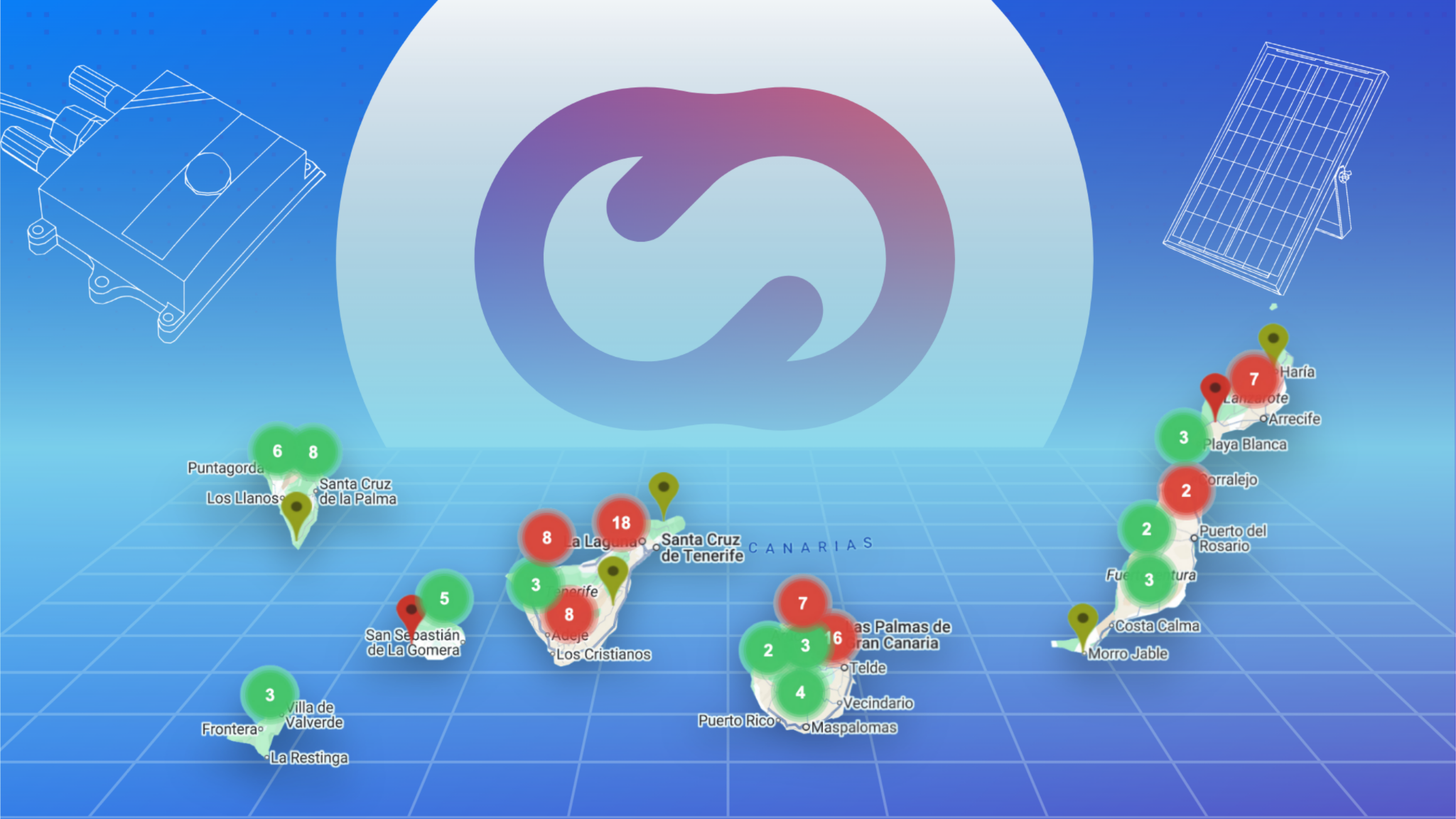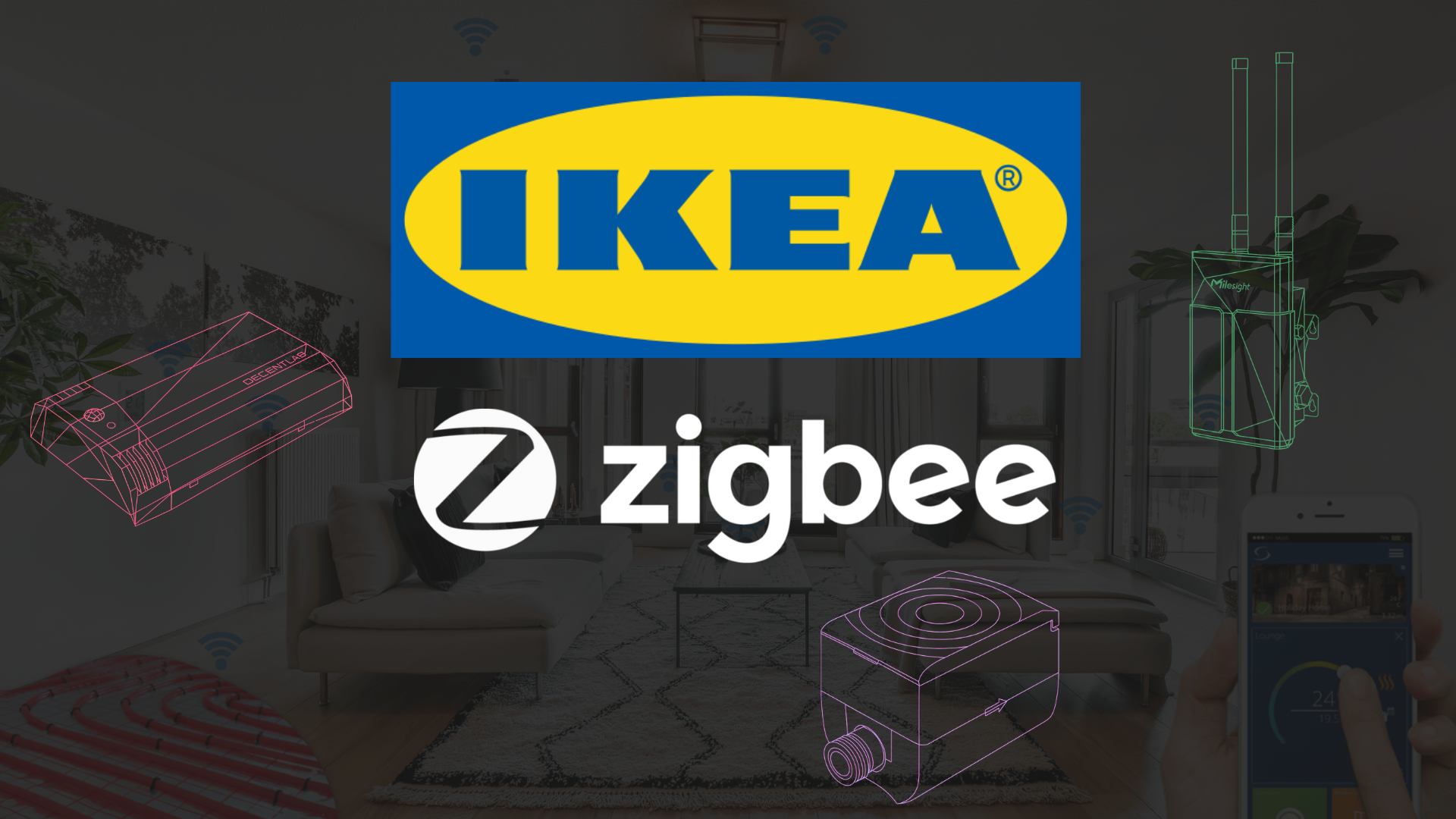Introduction
The Line project has captured global attention as a futuristic city that will redefine urban living in the middle of the Saudi desert. Designed to be fully sustainable, automated, and efficient, IoT in The Line will play a fundamental role in achieving these ambitious goals. In this article, we will explore what connected technologies will be deployed and how they will transform the way we live, work, and move in this innovative metropolis.

What is The Line
The Line is a planned futuristic city in northwest Saudi Arabia, part of the NEOM development and Saudi Vision 2030. It is designed as a 170-kilometer-long, 500-meter-tall, and 200-meter-wide linear city composed of two parallel mirrored skyscrapers stretching across the desert. The Line aims to house up to 9 million people in a car-free, zero-carbon environment, with all daily necessities within a five-minute walk. The city will run entirely on renewable energy, feature advanced artificial intelligence, and integrate nature throughout its structure. Construction began in 2022, with the first phase targeting completion by 2030, although recent reports suggest the initial segment may be smaller than originally planned
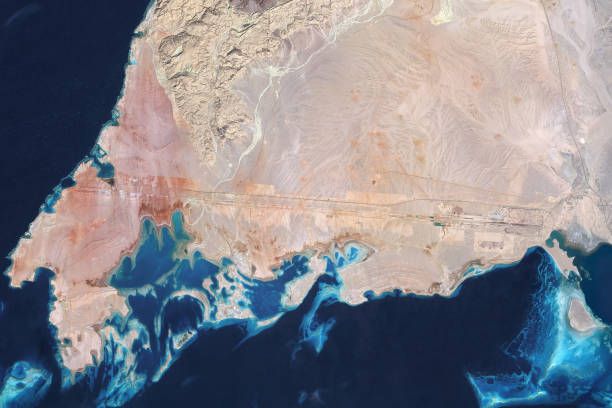 The Smart City from the space
The Smart City from the space
The Role of IoT in The Smart City

The Line’s IoT infrastructure will establish an unprecedented level of hyperconnectivity through a three-layered technological framework: physical sensor networks, ultra-fast data transmission systems, and AI-driven decision engines. This triad creates a living urban organism where every element interacts dynamically.
Automation of Urban Services
-
Adaptive lighting: Streetlights with embedded LIDAR and motion sensors will adjust brightness based on pedestrian density and lunar cycles, reducing energy use by 40% compared to conventional systems.
-
Smart water management: Self-repairing pipe networks with 5,000 sensors per kilometer will detect leaks within 3 seconds and automatically reroute flows while dispatching repair drones.
-
Waste revolution: Underground pneumatic tubes will transport sorted waste at 60 km/h to micro-recycling plants, with AI predicting collection needs down to individual building schedules.
Mobility Optimization
The spine of the transportation system will be a 20-minute cross-city rail flanked by autonomous mobility pods that achieve 99.999% operational uptime through:
-
Real-time passenger flow analysis using 8K facial recognition cameras
-
Dynamic rail scheduling adjusting train frequencies every 15 seconds
-
Predictive maintenance algorithms replacing parts 48 hours before predicted failures
Customizable Environments
Living spaces will employ shape-shifting architecture:
-
Walls with embedded microfluidic channels change room layouts
-
Electrochromic windows auto-tint based on circadian rhythms
-
Public plazas reconfigure seating arrangements via underground actuators responding to crowd density heatmaps1
Health Ecosystem Monitoring
A biometric mesh comprising:
-
25 million environmental sensors tracking 78 air quality parameters
-
Wearable device integration monitoring vital signs through epidermal electronics
-
AI epidemiologists analyzing cough sound patterns in real-time across 500,000 acoustic monitors
-
Nano-filter ventilation systems that eliminate 99.97% of pathogens within 30 seconds of detection1
This IoT matrix will generate 1.1 exabytes of daily data processed through quantum-enabled edge nodes, creating what engineers describe as “an urban nervous system with reflexive capabilities”. The system’s latency of 0.8 milliseconds between detection and response ensures synchronous adaptation to residents’ needs while maintaining energy consumption at 8 kW per capita – 93% lower than traditional smart cities
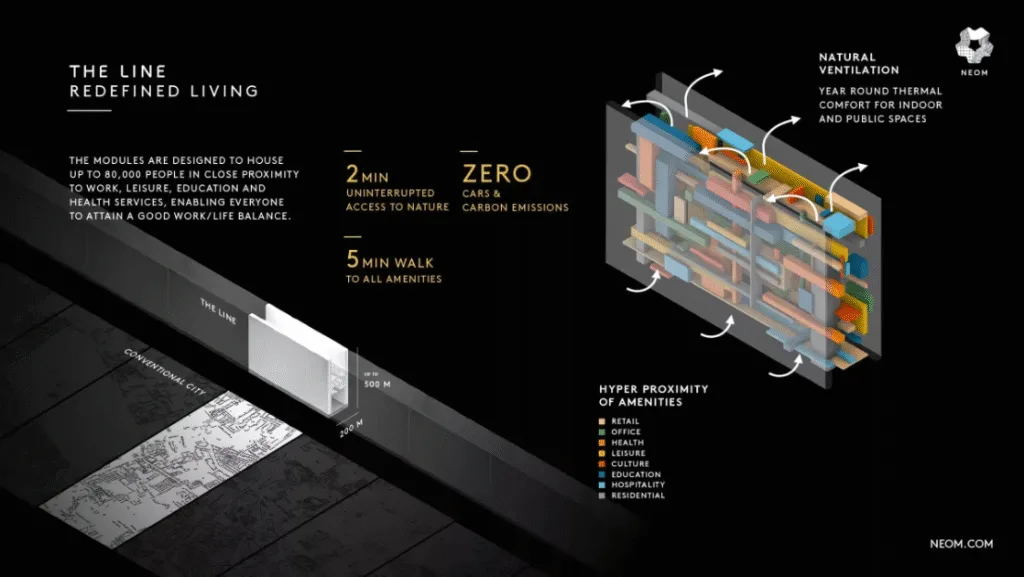 The line project layers
The line project layers
Key IoT Technologies in The Line
5G/6G Networks
The city’s neural network will employ multi-layer 5G infrastructure capable of 20 Gbps speeds and 0.5ms latency, with phased 6G upgrades enabling terabit-level data rates. Key features include:
-
Dual-band spectrum allocation: 3.5 GHz for wide coverage and 28 GHz millimeter wave for ultra-high-density zones like transportation hubs
-
Network slicing: 15 virtualized sub-networks dedicated to critical services (emergency response, microgrid control) and consumer applications
-
STC partnership: Deployment of 8,000 5G small cells per square kilometer, including underwater nodes for the artificial marina’s operations
This infrastructure will support 2.3 million connected devices per square kilometer – 47x denser than conventional smart cities
Distributed Smart Sensors
- Environmental mesh: 8K-resolution particulate matter sensors detecting 78 air quality parameters every 4 seconds
- Structural guardians: Nano-electromechanical systems (NEMS) in building skins monitoring stress tolerances with 0.01mm precision
- Hydraulic sentinels: Self-powered flow sensors in water pipelines identifying leaks within 300 milliseconds
- Biometric observers: 540,000 facial recognition cameras with emotion-detection algorithms optimizing public space utilization
Edge Computing & AIoT
- Level 1: 250,000 edge nodes handling time-critical tasks (traffic light control, drone navigation)
- Level 2: 45 neighborhood AI hubs executing machine learning models for energy distribution
- Level 3: Central quantum-AI hybrid systems solving city-scale optimization problems
AIoT fusion:
- Autonomous vehicles with onboard NVIDIA Orin chips processing 254 trillion operations per second
- Building Management Systems (BMS) using federated learning to share energy-saving patterns across sectors
- Predictive maintenance robots receiving real-time structural data via 6G-enabled digital twins
Digital twins
Digital twins in The Line will be real-time, data-driven virtual models of buildings, infrastructure, and the entire city, constantly updated via IoT sensors and AI analytics. These models will predict equipment failures, optimize energy and water use, and simulate the effects of new developments or emergencies. By enabling precise scenario planning and instant resource adjustments, digital twins will ensure efficient operations, support sustainable growth, and improve city management with unprecedented accuracy.. Do you want to know more about IoT? Visit our dedicated page.
Autonomous Mobility
Internal mobility will rely on interconnected autonomous vehicles and systems, from high-speed trains to electric micro-vehicles for last-mile transport.
Cognitive Cities
Thanks to advanced IoT and AI, The Line will operate as a cognitive city-learning from residents’ behaviors and real-time data to adapt services, anticipate needs, and optimize operations. This enables predictive, personalized management of transport, energy, and public spaces, creating a seamless and continuously improving urban experience.
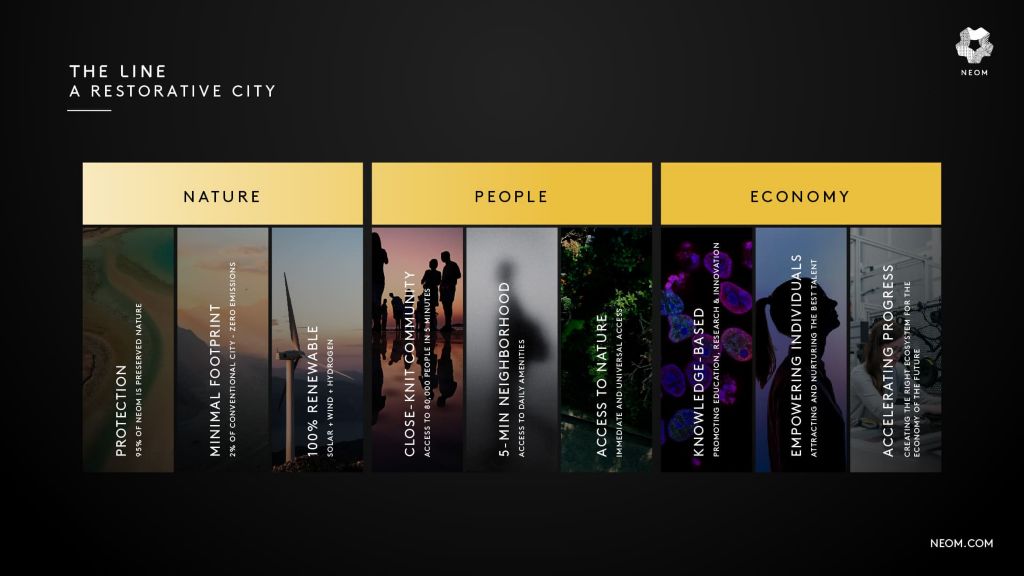 The line triple sustainability model
The line triple sustainability model
Challenges and Opportunities
Building the IoT backbone of The Line one of the most technologically ambitious urban developments in history poses an unprecedented set of challenges. As the city is envisioned to operate as a cognitive, fully automated, and interconnected urban ecosystem, the stakes for successful IoT integration are extremely high.
- Interoperability: The Line’s vast network over 2.3 million connected devices/km² requires flawless communication between systems from multiple vendors. Without standardized protocols and modular platforms, the risk of inefficiencies and data silos is high.
- Cybersecurity: With critical services relying on autonomous systems, the city’s infrastructure is a prime cyberattack target. Zero-trust models, quantum-resistant encryption, and real-time AI threat monitoring will be essential for resilience.
- Data Privacy: The use of facial recognition, biometric wearables, and AI-driven analytics demands strong ethical oversight. Trust will depend on Privacy by Design, decentralized data control, and transparent regulation.
- Sustainability: While The Line aims for net-zero emissions, deploying millions of devices and high-density data centers challenges that goal. Green IoT strategies, like solar-powered nodes and recyclable hardware, will be crucial.
However, the opportunities are equally monumental. The Line could become the first scalable model of a fully smart city, redefining urban living for the 21st century and serving as a living lab for emerging new technologies.
Opportunities
- Blueprint for Smart Cities
The Line could become the first scalable cognitive city, showcasing how automation, AI, and edge computing can support dense, livable urban environments with near-zero emissions and real-time responsiveness. - Tech Innovation Hub
It will serve as a living lab for 6G, digital twins, and quantum-edge AI setting global benchmarks in smart infrastructure. - Predictive Urban Management
IoT systems will allow for adaptive governance from public health alerts and energy distribution to dynamic mobility and space optimization. - Resident Empowerment
Smart dashboards, automated transit, and personalized health and energy tools will allow citizens to interact with and shape their urban environment like never before.
Conclusion

IoT in The Line will not only be an enabler; it will be the beating heart of this revolutionary city. By integrating sensor networks, edge processing, artificial intelligence, and data management platforms, The Line sets a new standard for future cities. Although the path is filled with challenges, the potential to transform our cities into more sustainable, safe, and human-centric places is unquestionable. The evolution of The Line will be a living testimony to how far the vision of a fully connected city powered by IoT can go.


